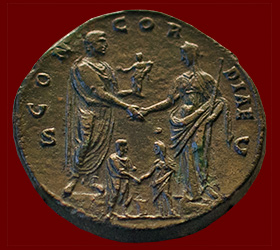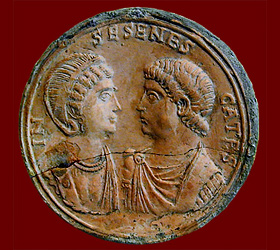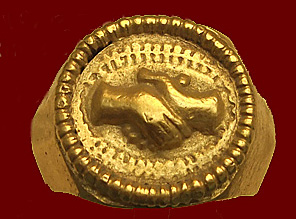 Concordia of the Imperial Family |
 Julia Augusti with her Sons |
 Wedding Salutation |
Marriage was a core institution of Roman culture, closely linked to the origins and well-being of the state as Rome's early legends attest: the marriage of Trojan Aeneas to Lavinia, princess of Latium, that was destined to establish the Roman race (Livy, AUC I.1; Vergil, Aeneid VI.760 ff., VII.254 ff.), the encounter of the Alban priestess Rhea Silvia with the god Mars that produced Rome's founders, the twins Romulus and Remus (Livy, AUC I.4; Vergil, Aeneid I.273-277), and the abduction of the Sabine women that secured citizen wives and children for Rome (Livy, AUC I.13). Rather than being a romantic pairing of vir and femina, the intention of iustum matrimonium was the production of new citizens for Rome. To this end the state offered qualified adults civic and social privileges to encourage legal marriage, as well as re-marriage upon the death of a spouse — common, given the regularity of war and the dangers of childbirth and disease — or after divorce, to which wives had equal access from the last half of the first century BCE. Recent philological, historical and archaeological scholarship has re-evaluated ancient literary and material evidence about marriage, increasing our appreciation of both the institution and its significance in Roman life.
Surviving Roman law contains no definition of Roman marriage.Instead, the section on marriage in Justinian's Corpus Iuris Civilis opens with a description of an idealised marriage by the early 3rd century CE jurist Herennius Modestinus:
Nuptiae sunt coniunctio maris et feminae et consortium omnis vitae, divini et humani iuris communicatio (Digest 23.2.1)
Marriage is a union of male and female and a partnership of all life, a sharing of divine and human law.
In his recreation of Romulus's speech to the Sabine women, Livy may be quoting (anachronistically) from an early Roman law that defined Roman marriage as a partnership:
docebatque . . . illas tamen in matrimonio, in societate fortunarum omnium civitatisque et quo nihil carius humano generi sit liberum fore (AUC I.9.14)
and he was informing them . . . that nevertheless they would be in matrimonium, in partnership [with their husbands] in the successes of everyone and of the state and in their children -- than which there was nothing dearer to the human race.
Extant Latin texts of the classical period reflect that the Romans used four words for marriage, apparently interchangeably: matrimonium, nuptiae, coniugium and conubium. However, while all can be translated as “marriage, matrimony, wedlock,” each has a specific reference.
Matrimonium refers to the social and economic institution of marriage and is used in a variety of phrases that signify the transfer of a woman from one household to another, as here in Caesar:
in matrimonium dare alicui filiam suam (Caesar, BG 1.3)
to give his daughter into the institution of marriage to someone.Nuptiae refers to the wedding rites, which were focused on the nupta, the veiled virginal bride; the word appears in the domestic comedies of Plautus:
coquere cenam ad nuptias (Casina 3.2.15)
to cook dinner for the wedding ceremony.Coniugium, the physical union of two people, is equally used for the marital bond and figuratively for the husband or wife, but it is not strictly reserved for marriage, as with matrimonium and nuptiae. Cicero writes to his friend Atticus:
de coniugio Tulliae meae. (Att. 6.8 1)
about the joining in marriage of my daughter Tullia.Conubium refers to marriage as a right of citizenship (ius conubii, the right to legal Roman marriage), as in Livy:
de conubio patrum et plebis C. Canuleius tribunus plebis rogationem promulgavit, (Livy, AUC 4.1.1)
the tribune of the people Gaius Canuleius introduced a bill for legalizing intermarriage between patricians and plebeians.
Matrimonium, the word deriving from mater, is the term surviving texts use almost exclusively in reference to the marriage of women. It suggests that the Romans understood the institution as essentially an instrument for transforming unmarried women into mothers.The purpose of marriage may have been written into early Roman law and lost but not forgotten, for some form of the phrase liberorum procreandorum causa ("for the purpose of producing children") appears regularly in Latin literature from the 3rd century BCE in Ennius (Andromeda 126), to Plautus (Captivi 889), to the classical authors C. Suetonius (Divus Iulius 52.3 ) and Aulus Gellius (Noctes Atticae XVII.21.44), and to Ulpian (Regulae 3.3) and the Edict of Probus (Codex Justinianus V.4.9). The function of the materfamilias was to produce legitimate, freeborn children (ingenui/ae) who would become full Roman citizens, assume their father's nomen and claim inheritance from him. While women were expected to be content with the goal of producing children, it was assumed that men would have their sexual needs satisfied by concubinae, meretrices and slaves.
Rather than define iustum matrimonium (Regulae Ulpiani 5.2), ancient texts list its prerequisites: possession of conubium, consent of both spouses and, if they are not independent, that of their patresfamiliarum (Digesta 50.17.30). Further, spouses had to be within an acceptable degree of kinship (see Justinian, Institutes I.10.1-11), to have reached sexual maturity (by the end of the Republic viri potens for girls was established at the age of 12 and pubes for boys at age 14), and to not be legally married. The jurist Ulpian also claimed that neither contracts nor documents nor cohabitation made a marriage (Digesta 20.1.4), but rather affectio maritalis ("the desire to be married"; Digesta 24.1.32.13).
Ancient sources define conubium as uxoris ducendae facultas, "the right to lead a wife in marriage" (Regulae Ulpiani 5.3). Although phrased as a male prerogative, the jurist Julian asserted that the requirement applied to women as well ("the masculine sex always contains also the feminine": Digesta 32.62). Only those persons who had Roman citizenship had conubium; foreigners, except in special circumstances, and slaves did not (Regulae Ulpiani 5.4-5).
While not all iniusta matrimonia were illegal, they did not share the privileges of valid marriage, among them the issue of citizen children and the right of inheritance.
Patria Potestas: in early Roman law all citizens were under the absolute authority (ius vitae necisque) of their paterfamilias (Gaius, Institutes I.52-54) until he died or made them independent (sui iuris). This authority, which the jurist Gaius termed distinctive to Roman culture (Institutes I.55), was held by each head of family over his dependents (for Ulpian's definition of familia, see Digesta 50.16.195.2). A son (filius familias) who was independent by reason of the death of or emancipation from his paterfamilias, became a paterfamilias himself upon marriage and then possessed his own patria potestas. Until that time, he was under the potestas of the oldest living head of his family (his father/grandfather/great grandfather). A daughter (filia familias) was subject to the patria potestas of her father until she entered a manus marriage, was emancipated by her father's death, or, rarely, was emancipated by him. In the latter two events, she entered tutela mulierum, a form of male guardianship which became less controlling by the end of the Republic (see Regulae Ulpiani 11.1; Gaius records that women were traditionally required to have male guardians because of their animi levitas [Institutiones I.144], an opinion he did not agree with [Institutiones I.190]; for a full explanation of tutela, see tutor).
Manus: a woman entered marriage either in manum, the most common legal arrangement before the 1st century BCE, or sine manu, a modern term for the alternative legal status which became the norm from the end of the 1st century BCE. Manus defined a married woman before the law as separated from the patria potestas of her paterfamilias (as well as all rights of inheritance from him), but subject to the legal control of her husband (if he was sui iuris), her position before the law similar to that of their children in respect to inheritance from her husband. If her husband was not independent (sui iuris), then she was legally subject, together with her husband, to his paterfamilias. Marriage sine manu was advantageous to the bride's natal family in that her property, including her dowry, after her marriage remained legally the possession of her paterfamilias; thus husband had only the use of her dowry as long as the marriage lasted and his wife lived.
In his commentary to the laws, Gaius writes that only a woman entered manus (Institutiones I.109) and that she did so upon marriage in one of three ways ( Institutiones I.110), the first being automatic, the second and third requiring action to be taken:
| Usus: A woman who retained her position as a married woman for an uninterrupted year came into manus by usus; the logic is that, as if she was obtained by possession for a year (usucapio), she transferred into the household of her husband and took the place of a daughter. Accordingly, it was decreed by the Law of the Twelve Tables that if a woman was unwilling to come into the manus of her husband in this way, she should be absent every year for three successive nights, and in this manner she would interrupt the usus of each year. But this whole law has been partly abolished by statutes, and partly cancelled by its very disuse. (Gaius, Institutiones I.111) |
| Confarreatio: Women come into manus by farreum, through some kind of sacrifice which is made to Jupiter Farreus, in which emmer wheat bread is employed, whence also it is called confarreatio; in addition, for the purpose of regulating this law, many other things are done and happen, with fixed solemn words, with ten witnesses present. This law is still in use in our time, for the principal flamines, that is priests of Jupiter, Mars, Quirinus, likewise kings of the sacred rites, are not chosen unless they are born of those married by confarreatio. And not even they themselves indeed can hold the priesthood without confarreatio. (Gaius, Institutiones I.112; Tacitus, in Annales IV.16, describes the Emperor Tiberius' discovery in 23 CE of the lapse of this form of manus marriage, which he modifies in order to salvage it) |
| Coemptio: In truth, women come into manus by coemptio through mancipatio (the ceremony of transference of property), that is, through a certain fictitious sale. For the husband buys his wife, whose manus she enters in the presence of not less than five witnesses, adult Roman citizens, likewise of a libripens (one who holds the scales in a ceremony of mancipium). Moreover, a woman can make a coemptio not only with her husband, but also with someone not in the family; obviously a coemptio is said to have been done on account of either matrimonium or of fiducia (trust); for a woman who makes a coemptio with her husband so that she lives with him as a daughter is said to have made a coemptio for the sake of matrimonium; but she who makes a coemptio for another reason, either with her husband or with someone not in the family, as for example for the sake of avoiding tutela (guardianship), she is said to have made a coemptio for the sake of fiducia. (Gaius, Institutiones I.113-114) |

While Roman marriage arrangements were dominated by men, wedding festivities centered around women, especially the nova nupta — her preparations, her appearance, her procession to and entry into her husband's domus, and life as a matrona. Surviving ancient texts use separate words for the state of being married (matrimonium) and the festivities (nuptiae) which by tradition began marriage for the upper classes: matrimonium established the new identity of the virgo as mater (the purpose of marriage being to produce citizen children), while nuptiae focused on the celebration of the virgin bride (nupta from nubere “to veil oneself”), with her face and head veiled protectively on her way to womanhood.
Not every bride experienced a wedding ceremony, since nuptiae neither defined nor were required for a iustum matrimonium (see Requirements above). Classical literature describes elite marriages (see Epithalamia: Catullus 61 for Vinia & Manlius, Catullus 62 choral song of youths and maidens, Statius 1.2 for Stella & Violentilla), but not all events would have occurred at every wedding. The nature of the celebration was determined by the wealth and status of the families and their desire to make public their union brought about by the marriage. It is probable that lower-class marriages took place with little or no ceremony other than the bride's change of residence, though the earliest surviving evidence for wedding festivities concerns a slave girl and her master (Plautus, Casina Act 4.3-4). It is probable that during the Empire, merchants and freedmen who could afford it sought to imitate aristocratic practice in regard to weddings as in other areas of their life.
Engagements (sponsaliae) were brokered and dissolved by the patresfamilias of the couple, who either consented or at least did not object to the union; Cicero from exile permitted his wife and daughter to arrange her engagement to her third husband (ad Familiares 3.12.2). A simple verbal exchange between males (spondesne? Do you promise? spondeo! I promise!) effecting a betrothal of marriage is found in three plays of Plautus (Trinummus 499 ff, 569 ff,1156 ff; Aulularia 255 ff; Poenulus 1156 f). Numerous examples exist of upper-class patriarchal matchmaking aimed at securing family interests related to public advancement, prestige, patronage, and property (e.g., Caesar's engagement of his daughter Julia to Pompey to secure their alliance). There is equally testimony of real affection between spouses in all ranks: Pliny and Calpurnia (Pliny Epistulae 7.5), the Laudatio Turiae, Paullus and Cornelia (Propertius Elegiae 4.11), and the ubiquitous carissima coniunx in funerary inscriptions during the Empire (see CIL 6.6209, CIL 6.18817).
The sponsalia was a public betrothal ceremony, a term which sometimes referred to the wedding feast as well. Here the families exchanged gifts, including a wedding ring (anulus pronubus) for the bride, who wore it on the third finger of her left hand. During the Republic the ring was made of plain iron or gold; in later years it was embossed with the image of the dextrarum iunctio, the joining of the couple's right hands, a gesture that signified fidelity and came to symbolize legal marriage on tombstones of the Empire. Scholars debate whether the clasping of right hands by the bride and groom formed part of the wedding ceremony; it is significant that the gesture is found on funerary monuments of all classes in the imperial period (e.g., freedman Afinianus, freedwoman Claudia Prepontis, unknown elite couple) as well as on the coinage of Emperor Antoninus Pius.
The marriage day was carefully chosen to avoid "unlucky" days (see Macrobius, Saturnalia 1.15.21; nefas, atri in calendar days): Ovid reports conferring with the Flaminica Dialis about an auspicious day for his daughter's wedding (see Fasti 6.219-234). Wedding festivities customarily opened in the home of the bride's natal family, but the ceremonies mentioned in the sources of taking the auspices, offering sacrifice to the familial gods (see Plautus, Aulularia 2.8), and signing the marriage contract may have taken place in her home or in the groom’s, perhaps even on an earlier day. Nuptial sacrifices and attendant prayers were not uniform and may have been customary if not required (see confarreatio marriage, above), some taking place before the wedding day. They may have included offerings of wine and aromatic incense, predominantly to the Lares, but perhaps also to Venus, Cupid, and Concordia, deities often associated with weddings. The couple's houses were draped with floral garlands and ribbons as signs of the occasion. Events on the day featured the lighting of wedding torches (taedae), banqueting, music and dancing, choral songs (epithalamia), chants (hymen hymenae, Talasio), and coarse jests (versus fescennini) accompanied by walnuts tossed to bystanders (Pliny, Naturalis Historia 15.86). Lucan's poignant description of Marcia and Cato's remarriage in 49 BCE before he left for war, doubtless the inverse of their first wedding celebration, evidences wedding traditions among the elite (Pharsalia 2.350-391; see also Marcia).
At some point the guests arrived and witnessed the marriage/dowry contracts (tabellae nuptiales/dotales), presumably the scroll clutched in the groom's left hand carved in wedding scenes on many funerary monuments. No contract was necessary for a marriage to be valid, but the witness of their signing by guests at the celebration was evidence that the wedding had taken place and/or the dowry promised (Tacitus notes that the false weddings of Messalina to Silius in 48 CE, Annales 11.27, and Nero to Sporus in 67 CE, Annales 15.37, were legitimized by guests witnessing and signing the marriage contracts). While the presence of an auspex was not required at the ceremony, that of the Pronuba was. A matrona married only once (univira) whose husband was still living, she is portrayed on funerary monument reliefs standing between and embracing the bridal couple. Her presence has also been interpreted as metaphorical, with the pronuba identified as Juno or the personification of the marital virtue Concordia.
Important events in Roman life were marked by distinctive, traditional dress and the wedding was no exception. Since the bride was the focus of attention, every aspect of her appearance was significant and ritually prescribed, though not all brides experienced all of the elements of the elite wedding described below. Latin terms associated with the wedding day suggest that its two key aspects were the flammeum, the bride's flame-colored veil, and the deductio in domum mariti, the public procession of the veiled bride from her parents' home to her husband's. The role of the bride (nova nupta) was to "put on a veil for her husband" (nubere viro), while that of the groom (maritus) was to "lead a wife" (ducere uxorem) to his home where, "joined" in marriage (iungere, coniugium), the partners (coniuges) would begin their life together as husband and wife.
Nova Nupta
Preparations for the day involved the women of her family, especially the bride’s mother (cf. Apuleius, The Golden Ass 4.26), who was chiefly responsible for her adornment. On the day before the ceremony the bride put away the purple-bordered toga praetexta worn by citizen children (cf. Propertius, Elegiae 4.11.33 and modern reconstruction), signifying that she had reached the age to be married (see Requirements above). On the eve of her wedding day she slept in a white tunic (see tunica recta in Pliny, Historia Naturalis 8.194), which by tradition she had woven herself, and a golden hairnet (reticulum). Her tunic was seamless, woven of wool on a standing loom. Worn on her wedding day, it was cinched at the waist with a belt (cingulum) closed with a Hercules knot (nodus Herculaneus), symbolic at once of her fidelity and fertility, which her husband would unbind on their wedding night. Wealthy brides might also have worn the jewels (gemmae) and pearls (margaritae) which were part of their dowry (see Fundanus' provision for his daughter's wedding in Pliny, Epistulae 5.16.7). On her feet the nova nupta wore slippers (socci lutei) dyed with luteum, to match her bridal veil. The plant luteum yielded a distinctive color on the yellow-red spectrum (see a modern day reconstruction) that was exclusive to the bridal flammeum (see Pliny, Historia Naturalis 21.22.46: lutei video honorem antiquissimum, in nuptialibus flammeis totum feminis concessum) meant to shield the nova nupta from evil fortune as she moved from the protection of her family household gods to those of the groom. Beneath the veil and so not visible on surviving portrayals, the bride’s hair was elaborately styled, according to an ancient ritual that would have required the assistance of her attendants. It was said to be parted in the middle with a bent iron spearhead (hasta caelibaris; see Plutarch, Quaestiones Romanae 87) and braided into six sections (seni crines/sex crines), each tied with white woolen ribbons (vittae) and wrapped around her head (see a video recreation). On her head the bride wore a crown of herbs and flowers (corona/corolla; see Phonoe's bridal headdress in the mosaic of her marriage to Bellerophon; also Catullus, 61.6-10 on the appearance of the bride).
Deductio in Domum Mariti
At the approach of Hesperus, the evening star, the groom left the festivities to await his bride in front of his house (Catullus 62; see also Carmen LXII). Attendants, performers, and well-wishers gathered at the bride's house to escort her with chants, jokes, song and banter from her mother's arms to husband and new home (Catullus 61.76-135): groomsmen, maidens, musicians, dancers, young boys bearing gifts, her belongings and blazing wedding torches to light her way safely (cf. the kidnapped bride in Apuleius, Metamorphoses 4.22-7; see Varro, De vita populi Romani 2.78, who writes that a freeborn boy carried a torch that was lit from her home hearth). Upon her arrival the bride may have enacted her new role as domina in any of the several rituals preserved in our sources: she brought her spindle and distaff with her (Plutarch, Quaestiones Romanae 31); she spoke the formulaic words ubi tu Gaius, ibi ego Gaia (Plutarch, Quaestiones Romanae 30); she carried to her new home three asses to be given to her husband, his lar familiaris, and his lar compitalis (Nonius, De Compendiosa Doctrina 852L); she annointed the door posts of her new house with wool dipped in lard (Pliny, Historia Naturalis 28.136, 28.142, 29.30); she was lifted over the threshold by her attendants (Plutarch, Quaestiones Romanae 29); she received fire and water from her husband (Plutarch, Quaestiones Romanae 1; Ovid, Fasti 4.787 ff.). At the end of the evening, the bride was escorted by her attendants to her bridal chamber, where she spent the night with her husband (cf. Plutarch, Quaestiones Romanae 65; Catullus 61.166-215). On the following day, she assumed her duties as materfamilias and made sacrifice on the altar of her new home (Macrobius, Saturnalia 1.15.21-2).

K. Cooper, The Virgin and the Bride (Harvard UP, 1996); J.F. Gardner, The Family and Familia in Roman Law and Life (Clarendon, 1998); J. E. Grubbs, Women and the Law in the Roman Empire (Routledge, 2002); K. K. Hersch, The Roman Wedding (Cambridge UP, 2010), "Introduction to the Roman Wedding: Two Case Studies" in Classical Journal 109.2 (2013) 223-232, ed. A Cultural History of Marriage in Antiquity (Bloomsbury Academic, 2023); L. La Follette "The Costume of the Roman Bride," in The World of Roman Costume(eds. Bonfante and Sebesta, U Wisconsin Press, 1994); L.L. Loven, A. Stromberg, eds, Ancient Marriage in Myth and Reality (Cambridge Scholars, 2010); J. H. Oakley, R. H. Sinos, The Wedding in Ancient Athens (University of Wisconsin Press, 1993); V. Panoussi, "Brides" in Brides, Mourners, Bacchae (Johns Hopkins UP, 2019), pp. 16-81; M. Horatius Piscinus, "Nuptiae: Roman marriages" in Societas Via Romana ; W. Smith, Dictionary of Greek and Roman Antiquities s.v. Matrimonium (John Murray, 1875); O. Thomsen, Ritual and Desire (Aarhus UP, 1992); S. Treggiari, Roman Marriage (Clarendon, 1991), "Digna condicio," Echos du Monde Classique/Classical Views 28.3 (1984) 419-51, "Putting the Bride to Bed," ibid. 38.13 (1994) 311-31, "Marriage and Family in Roman Society," in Marriage and Family in the Biblical World (ed. Ken M. Campbell, InterVarsity Press, 2003), pp. 132-182; K. Wasdin, Eros at Dusk (Oxford UP, 2018).